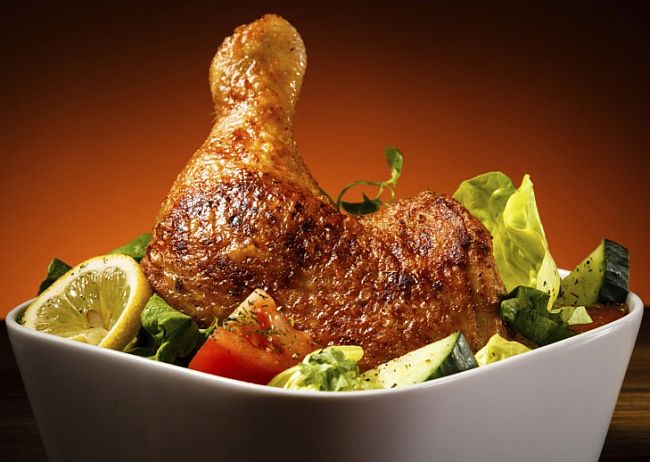Selected Halachos from the “One Minute Halacha” project
By HaRav Yosef Yeshaya Braun, Shlita Mara D’asra and member of the Badatz of Crown Heights
 HOW TO SOURCE KOSHER MEAT
HOW TO SOURCE KOSHER MEAT
“Hakasher she’betabachim shutafo shel Amalek” ([Even] the most virtuous butchers are cohorts of [the evil nation] Amalek), states the Mishna. It is particularly difficult for sellers of poultry and meat—who stand to lose significantly if critical stock is found to be substandard—to avoid the temptation of fudging on the kosher status of meat they sell. The melech zaken uk’sil (old and foolish king, aka the yetzer ha’ra—evil inclination), writes the Chasam Sofer (18th century Rav and halachic author), sits contentedly on a throne that rests on three legs, one side propped up by the butchers who sell treif (non-kosher) meat with a kosher label.
It is therefore imperative that the kosher consumer be discerning in sourcing their kosher meat and chicken to make sure that the hashgacha (kosher supervision) is of the highest and most conscientious standard— and not rely on the goodwill of even generally honest and G-d-fearing vendors, who are, unfortunately some of the yetzer hara’s favorite victims.
There are myriad details that must be properly supervised— from the time prior to the sh’chita (kosher slaughter) of the kosher animal or fowl up to the purchase of the endproduct— to ensure that they are performed in the optimal manner. It begins with the qualifications of the shochet, the conditions of the sh’chita and the status of the chalef (slaughtering knife)—which should be checked regularly by someone other than the shochet.
After sh’chita, there must be a proper b’dika (inspection) of the vital organs; a visual test is insufficient and the shochet must check the fowl or animal by hand. For kosher fowl, the simanim (“signs”, i.e. the trachea and esophagus) are checked through tekifas agudal (pushing down with the thumb) and for animals, the examination is performed by running the hand over the relevant parts. In addition, both a b’dikas p’nim (internal check) and b’dikas chutz (external check) of the lungs of kosher animals is required to ensure that there are no problematic adhesions. (Which adhesions disqualify the animal as kosher varies according to differing standards of glatt kosher meat and divergent halachic opinion.) There is also an inspection for other treifos ([pre-existing conditions that render fowl or animal] unkosher) such as checking chickens for tzomas hagidin (the juncture of the tendons) to assure they are not torn, buka d’atma, (the hip joints) examined for dislocation).
The b’dika is followed by nikur (“excision,” the process of removing non-kosher components) of major blood vessels, the gid hanasheh (sciatic nerve) and purging chailev (nonkosher fats)—a process that necessitates the complete removal of the animal’s hindquarters. Any pooled or coagulated blood or bruised meat is also removed.
Then the meat is kashered (blood removed via soaking, rinsing and salting) under particular conditions and within the appropriate timeframe, and it must be ensured that the final product is properly sealed with two chosamos (seals). Once the meat leaves the purview of the mashgichim at the kosher packing plant, there must be no evidence of tampering; it is halachically problematic to purchase chicken or meat if the packaging is defective.
SOCIALIZING AND EATING WITH STUDENTS
A melamed (Torah teacher) is restricted from kibitzing with his students during play and eating and drinking together with them. This limitation would seem difficult to uphold for a melamed who spends most of the day with children, and in practice, exceptions are commonly made. Poskim explain that the constraint on eating with the children applies only to actually joining them for a meal or drink on a regular basis. It doesn’t limit a melamed from taking his meals while students are present; it applies only to eating at the same table. Practically, a teacher may also sit together with students in a non-social atmosphere, while each eats their private meal.
In the Shulchan Aruch it speaks of a Pesach Seder meal that includes a teacher and his students; if the restriction of eating and drinking with students would unilaterally apply, such a situation would not be halachically sanctioned. A clear exception is made for a meal that is a seudas mitzvah (a meal for a mitzvah [occasion]), and to a melamed dining occasionally with students for other reasons.
“One Minute Halacha” is a succinct daily presentation on practical and contemporary Halacha in video, audio, and text formats, and can be accessed by phone at 718.989.9599, by email, halacha2go@gmail.com, or by WhatsApp 347.456.5665.